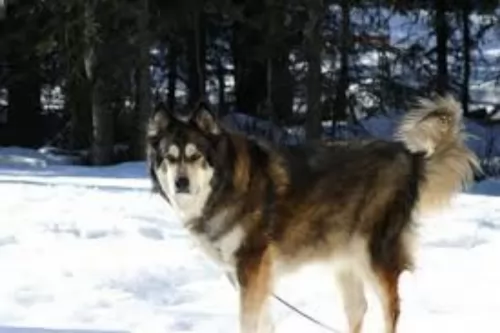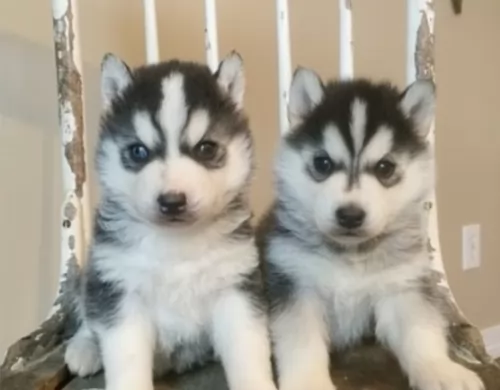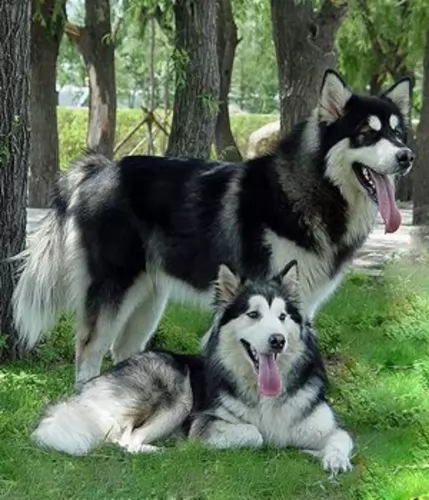 MyDogBreeds
MyDogBreedsMackenzie River Husky is originated from United States but Guejae Gae is originated from South Korea. Mackenzie River Husky may grow 16 cm / 7 inches higher than Guejae Gae. Mackenzie River Husky may weigh 20 kg / 45 pounds more than Guejae Gae. Both Mackenzie River Husky and Guejae Gae has same life span. Both Mackenzie River Husky and Guejae Gae has almost same litter size. Both Mackenzie River Husky and Guejae Gae requires Moderate maintenance.
 The name Mackenzie River Husky was given to these huskies by those wanting to name the freight huskies of a certain area. The name took hold in the 1960’s, but the dog began to disappear with the introduction of snow machines.
The name Mackenzie River Husky was given to these huskies by those wanting to name the freight huskies of a certain area. The name took hold in the 1960’s, but the dog began to disappear with the introduction of snow machines.
They’re a mixture of native sled dogs - Newfoundlands, St. Bernards, Staghounds and Wolf. As a mixed breed, they have always been regarded as classic sled dogs.
Known also as Gaulchae Gae, the Guejae Gae hails from Korea, and falls in the Spitz dog category. The dog is related to the Korean Jindo dog but is slightly larger.
With his sharp canine teeth, the Guejae has been used for hunting and herding, having enough stamina to not easily give up on its prey. The dog isn’t AKC recognized.
 The beautiful Mackenzie River Husky stands at 66 to 74cm in height and weighs between 29 and 47kg.
The beautiful Mackenzie River Husky stands at 66 to 74cm in height and weighs between 29 and 47kg.
This deep chested dog has a long, straight coat with the colors being typically wolf-like – white, cream, black, tan, blonde and red. He has erect ears, long legs and a long, bushy tail.
This wolf-type dog is strong willed and independent and was always a pack dog. They wouldn’t be described as a good choice for the first time dog owner as they do seem to have some wolf traits and will require a strong, firm, level headed owner.
This is a medium sized dog, standing at roughly 40cm to 58cm and weighing about 16 to 27kg, and because he falls into the Spitz dog category, you’ll find them with the characteristic pointed ears and thick fur.
He can be in a number of colors such as fawn, brown, white, grey or black. The tail curls up over the back too and the dog has a resemblance to the wolf. You can see he is intelligent as has he has bright, alert eyes.
These dogs aren't aggressive and they are known to be gentle dogs who are devoted and loyal to their owners.
He is an active, intelligent, social dog who wants ongoing interaction with his human family. He should never be left alone in the back yard day after day as he becomes lonely and bored. This is terrible to do for any dog breed, but the Guejae Gae won't thrive in a family who doesn't make him 100% part of the family.
He should be allowed indoors with his owner as he is a highly social dog who loves being around his human family, forming deep bonds with them.
His superb intelligence allows him to learn new commands and tricks easily, and this is why he responds well to training and socialization. He makes a great pet for active owners and gets on well with children in the home as well as pets. Because he is somewhat reserved around strangers, he makes a good watchdog too.
 Your MacKenzie River Husky is such a likeable pet to have. True, he does tend to be a bit stubborn and independent but there is nothing that training and socialization won’t do for him. You’ll find him much more obedient and amicable, and he gets on well with children and pets in the home.
Your MacKenzie River Husky is such a likeable pet to have. True, he does tend to be a bit stubborn and independent but there is nothing that training and socialization won’t do for him. You’ll find him much more obedient and amicable, and he gets on well with children and pets in the home.
He is an intelligent dog too and very energetic so will require an owner who is active, firm and consistent. He thrives on human company and just wants to be around his owner all the time, ready to join in with any activity happening in his life.
He is therefore far more suited to life in the countryside than to the city. Loyal, devoted and loving, a MacKenzie River Husky isn’t only a beautiful dog to own, he promises to offer everything you want in a 4-legged friend.
Intelligent, playful, faithful and loving, your Guejae Gae is going to make you a splendid pet – good with other pets in the home as well as with children.
They are good natured pets and easy to train too, so that when he has been trained and socialized, he becomes an even more amicable pet.
Just remember though that these dogs have been used as working dogs and to ensure your Guejae Gae makes you a splendid pet, you want to ensure he has enough exercise to keep him happy and healthy.
 Your MacKenzie River Husky, regardless of how healthy he is, can suffer with some common health problems that all dogs are prone to.
Your MacKenzie River Husky, regardless of how healthy he is, can suffer with some common health problems that all dogs are prone to.
Perhaps one of the more common health problems that this particular dog breed has to contend with is cataracts, hip dyslasia and hypothyroidism.
Many people associate cataracts in dogs with age, little realizing that there are many medical reasons as to why our pets develop cataracts. Cataracts can start as early as 6 months of age, although this is unlikely. They come about because of a disease which affects the lens of the eye, causing the lens to lose its transparency.
You’ll notice a whitish/grey shade in your dog’s eye and this can actually impair vision. Cataracts are particularly the lot of diabetic dogs. It can certainly help to have your dog’s eyes checked by a vet regularly.
This is another fairly common problem with Huskies. It’s almost like a death sentence if your MacKenzie is a working dog because it can lead to lameness. The disease can lead to problems in the hip joint which cab be debilitating ad give your dog a lot of pain.
It doesn’t strike old dogs only, but can be the lot of young dogs too. Sometimes treatment will require surgery but there are non-invasive options too. You want to make sure that you don’t allow your pet to become overweight as this can contribute to developing hip dysplasia.
There are always common dog illnesses to watch out for however, and in this spitz-type dog, hypothyroidism is one.
Hypothyroidism in dogs is usually brought on by inflammation of the thyroid gland. Hypothyroidism occurs more often in medium to large dogs as opposed to smaller breeds. The most common signs of low thyroid function in your pet will be loss of fur and excess shedding, weight gain and an inability to tolerate the cold.
Hypothyroid dogs often battle with ear infections as well as skin infections. There are a number of blood tests to confirm a suspected diagnosis of hypothyroidism in your dog.
 Huskies like this one will require a good deal of exercise every single day. These are working dogs who have always had a job to do and you can certainly count him in when you do your hiking walks, swimming – you name it. The only thing he will object to is that he doesn’t do well in hot weather. Strong-willed, you’ll want your MacKenzie River Husky trained and socialized if you want him to be a companionable dog.
Huskies like this one will require a good deal of exercise every single day. These are working dogs who have always had a job to do and you can certainly count him in when you do your hiking walks, swimming – you name it. The only thing he will object to is that he doesn’t do well in hot weather. Strong-willed, you’ll want your MacKenzie River Husky trained and socialized if you want him to be a companionable dog.
Dogs need to be fed according to the size, their age and their lifestyle. If your MacKenzie River Husky is an active working dog, his food must be the very best and contain enough calories to cover the daily caloric expenses.
Quality and the amount of vitamins and minerals in the food is most important for a dog like this. If you feed him commercially manufactured food, make sure its high quality and not made up of fillers, and other bad stuff. Read the label and understand exactly what’s going into your dog’s stomach.
Simplicity with feeding is best for your pet. Treat him occasionally to cooked chicken, brown rice, pasta and cooked or raw vegetables which can be added into his dry kibble. A dog like this will require some raw meat as well to ensure his coat and eyes are always shiny and bright.
Grooming of the MacKenzie River Husky must be done at least twice a week to get rid of loose hairs.
He sheds quite a bit and more so in hot weather so he will need to be thoroughly brushed twice a week.
The Guejae Gae is an active dog breed that needs plenty of place to roam freely, and therefore he is a dog breed that will suit life in the country far better than life in the city.
You will need a decent sized yard for him and you should also be prepared to take him on walks and play ball games with him. He is such a social dog and playing with him is something that will strengthen your bond.
As a Spitz type dog, the Guejae Gae has always enjoyed a carnivorous diet. Cheap, poor quality commercially manufactured dog food won’t cut it for these dogs. Home cooked meals with natural ingredients such as chicken, brown rice and vegetables is a good choice as well as adding in some raw meat from time to time.
Always remember when feeding your Guejae Gae that how much your dog eats will depend on his size, age and activity levels. A highly active dog like the Guejae Gae needs wholesome food as well as a constant supply of fresh, cool water.